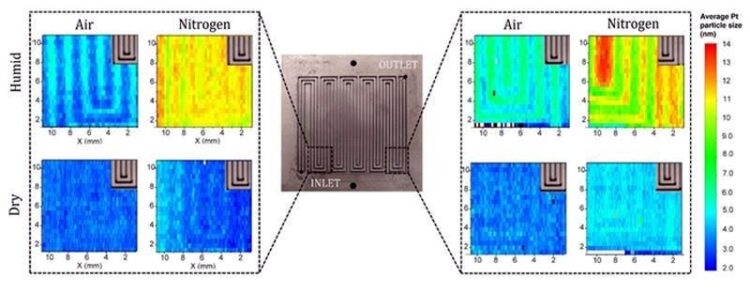Fuel-cell waste reduction goes platinum

In fuel cells, hydrogen gas flows through channels in membranes coated with platinum catalyst. Platinum degradation (redder colors in insets) can be affected by the presence of other gases (air or nitrogen), humidity, and location (flow inlet vs. outlet).
Image courtesy of University of California, Irvine
Understanding platinum degradation could reduce waste and lower cost of a promising green technology, hydrogen fuel cells.
The Science
Fuel cells generate electricity from hydrogen, a “clean” fuel that produces only water when burned. Platinum is a key catalyst in this process. However, platinum degrades unevenly in fuel cells, resulting in still-usable platinum being discarded when “worn out” fuel cells are replaced. To improve fuel cell durability and reduce waste, this research studied the causes of uneven platinum degradation. These causes include the humidity and gas environment (air vs nitrogen) inside the fuel cells and the geometry of the fuel cell flow channels.
The Impact
Polymer electrolyte fuel cells (PEFCs) are an attractive option for use in automobiles because they are compact and can quickly ramp up power output as needed. Lower cost and greater durability would encourage their wider use. For light-duty vehicles, precious-metal catalysts such as platinum can account for about a third of the cost of PEFCs. In this study, scientists studied patterns in the deterioration of platinum catalyst in PEFCs. The results led to simple, effective strategies to reduce the waste of precious catalyst material.
Summary
A team led by the University of California, Irvine and Bosch studied commercially available catalyst-coated membranes that were subjected to accelerated stress testing. They performed tests under humid and dry conditions and in air and nitrogen environments. Their analysis of the samples involved a variety of methods, including scanning electron microscopy and several X-ray spectroscopy techniques. At the Advanced Light Source (ALS), a Department of Energy (DOE) user facility, the scientists used X-ray diffraction to map the sizes of the aged platinum nanoparticles (larger particles indicate greater degradation). They also used X-ray computed tomography to image the catalyst layers after aging.
The results revealed that platinum ages faster near flow-field outlets, as well as in nitrogen environments and in higher humidity. Aging was also accelerated in the spaces between the maze-like channels that guide hydrogen gas through the catalyst layer, an effect that disappeared for narrower flow-field dimensions. The study concluded that the addition of counter-flow channels could help reduce inlet/outlet variability, and that higher-temperature operation could help maintain lower relative humidity. PEFC vehicles are an excellent emission-free alternative to fossil-fuel vehicles. The results from this study can aid in the development of immediate system-level strategies to increase durability and reduce costs until alternate, lower-cost catalyst materials are found for this technology.
Funding
The research was funded by Bosch Research. This research used resources at the Advanced Light Source, a DOE Office of Science user facility located at Lawrence Berkeley National Laboratory.
Media Contact
Michael Church
DOE/US Department of Energy
michael.church@science.doe.gov
Office: 2028416299
ORIGINAL SOURCE
https://www.energy.gov/science/bes/articles/fuel-cell-waste-reduction-goes-platinum
All latest news from the category: Studies and Analyses
innovations-report maintains a wealth of in-depth studies and analyses from a variety of subject areas including business and finance, medicine and pharmacology, ecology and the environment, energy, communications and media, transportation, work, family and leisure.
Newest articles

Innovative 3D printed scaffolds offer new hope for bone healing
Researchers at the Institute for Bioengineering of Catalonia have developed novel 3D printed PLA-CaP scaffolds that promote blood vessel formation, ensuring better healing and regeneration of bone tissue. Bone is…

The surprising role of gut infection in Alzheimer’s disease
ASU- and Banner Alzheimer’s Institute-led study implicates link between a common virus and the disease, which travels from the gut to the brain and may be a target for antiviral…

Molecular gardening: New enzymes discovered for protein modification pruning
How deubiquitinases USP53 and USP54 cleave long polyubiquitin chains and how the former is linked to liver disease in children. Deubiquitinases (DUBs) are enzymes used by cells to trim protein…



